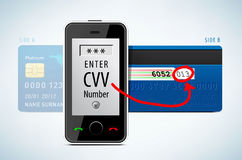|
Card Verification Code (CVC)
The whole security concept behind the Card Verification Code or CVC displayed on credit cards is weak, counter-productive, and provides additional security risks to the credit card usage and protection process. For those who don’t know what a CVC is, it’s the last 3 digit number located on the back of your MasterCard credit card. This code has various names and in fact VISA calls it Card Verification Value or CVV, and Discover calls it Card ID or CID. The purpose of the code is the same regardless of what each credit card company calls it or where it places it on the card. For example, American Express places its 4 digit code on the front of the card in the top right corner. The credit card companies introduced the code to help confirm that a genuine card is being used during a transaction, especially in situations like mail orders, phone orders or Internet orders where the card is not present. This is exactly where I start having problems with the concept. As you may have noticed, when you purchase something on the phone using your credit card, the seller usually asks you for the code to make sure you are in the possession of the card, however, when you purchase something in a store using your card, you’re not asked to provide the code because the card itself along with an ID card is used to process the transaction instead of its number being entered such as in the case of phone orders. Supposedly, the consumer’s knowledge of the code allows the merchants to make accept or reject decisions for processing credit card transactions and reducing credit card fraud. Recently, when I was shopping with my credit card, I noticed the merchant was looking very carefully at my credit card. It was hard for me to tell whether the merchant was reading my name out of curiosity or the card code, but my point is it’s all very easy for others to access my card verification code during my in-store purchases when using my credit card. When our credit card numbers and their codes imprinted on the credit cards are so routinely shared with others, doesn't it defy its purpose to verify card authenticity and ownership? Can’t someone with easy access to my card number and the card verification code purchase items by phone pretending to be me using my card? This whole concept defies its purpose when the number is routinely visible and shared with others. Until banks improve their credit card protection practices, one way consumers can protect themselves against CVC fraud is to cover the code with paper and tape while using their cards for in-store purchases. There is no need for merchants to see the code while processing the credit card transactions. |